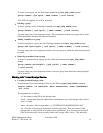Maximum Request Threads. The maximum number of concurrent client requests allowed.
Advice - If the Location Server is reporting heavy loads, increase this number. If this number is above
300, consider replicating the Location Server on a different machine. Note if this value is changed, the
general configuration thread value (Thread Pool Size) should be adjusted so that its value is always
larger than the Maximum Request Threads. See Section 5.1.1.2: Interface Controls on page 92.
Maximum Request Threads should not normally exceed (Maximum Location Map Threads + 400).
This is not enforced. If you need more threads than this to handle the load, consider configuring an
additional Location Server.
Maximum Location Map Threads. The maximum number of threads allocated to contact other
Location Servers concurrently.
Advice - The actual number of Location Map threads used is Maximum Location Map Threads or the
number of other HPSS installations to contact, whichever is smaller. This value does not need to be
changed unless the system is experiencing timeout problems contacting other Location Servers.
Location Map Timeout. The maximum amount of time in seconds to wait for a Location Server to
return a location map.
Advice - This value should be changed only if the system is experiencing very long delays while
contacting another Location Server.
Local HPSS Site Identification:
HPSS ID. The UUID for this HPSS installation.
Local Site Name. The descriptive name of the HPSS installation.
Advice - Pick a name to uniquely describe the HPSS system.
Local Realm Name. The name where the realm containing Location Server path information should be
stored.
Advice - All clients will need to know this group name since it is used by them when initializing to
contact the Location Server. If the default is not used, ensure that the associated environment variable
for this field is changed accordingly for all HPSS interfaces.
2.4.3. Deleting a Location Policy
The Location Policy can be deleted using the Location Policy window. Since only one Location Policy
may be defined in a system, and it must exist for the system to run, it is better to simply update the policy
rather than delete and recreate it. See Section 2.4.2: Location Policy Configuration Window on page 27
for more details.
2.5. Restricting user access to HPSS.
System administrators may deny access to HPSS to specific users by including that user in a
configuration file that is read by the HPSS Core Server. This file is read by the Core Server at start up
time and also read again when the SSM Administrator presses the Reload List button on the Restricted
Users window or whenever the Core Server receives a REINIT request. Any user in this file is denied
the usage of the HPSS system completely. To set up this file, you must do the following:
HPSS Management Guide November 2009
Release 7.3 (Revision 1.0) 28


















